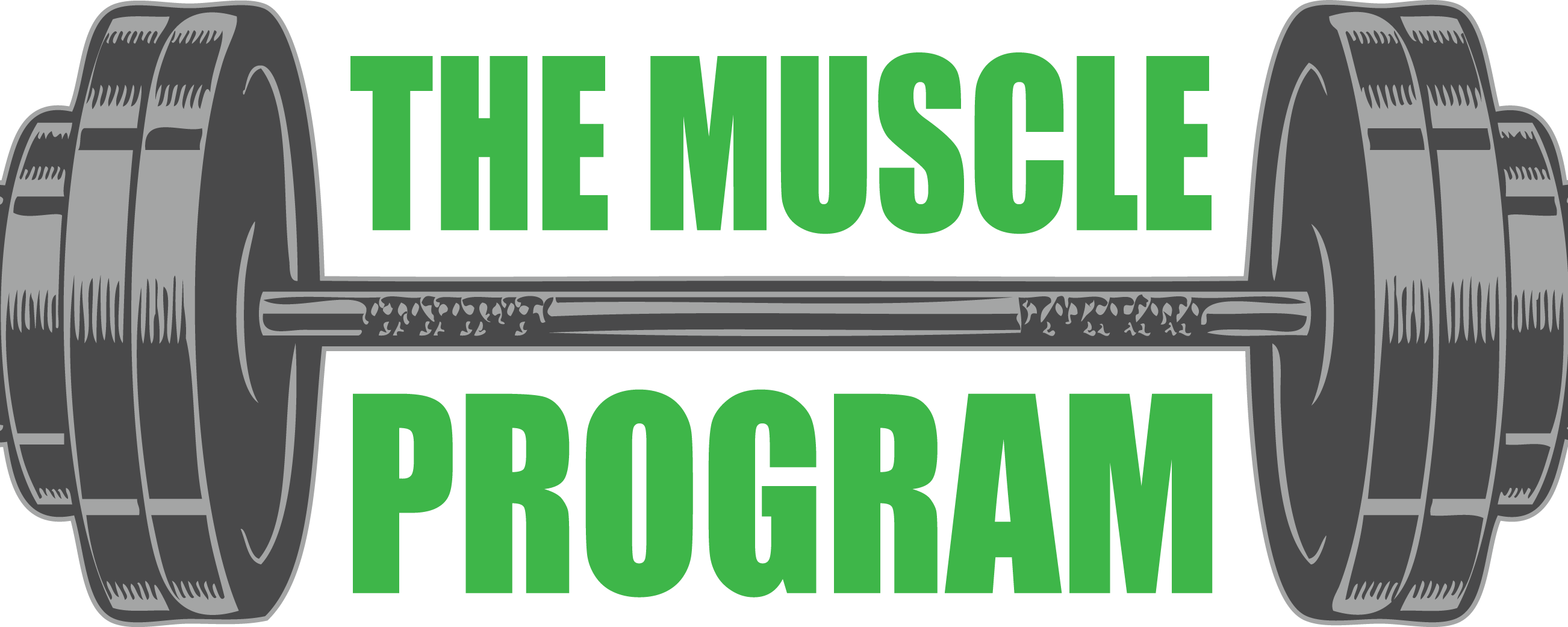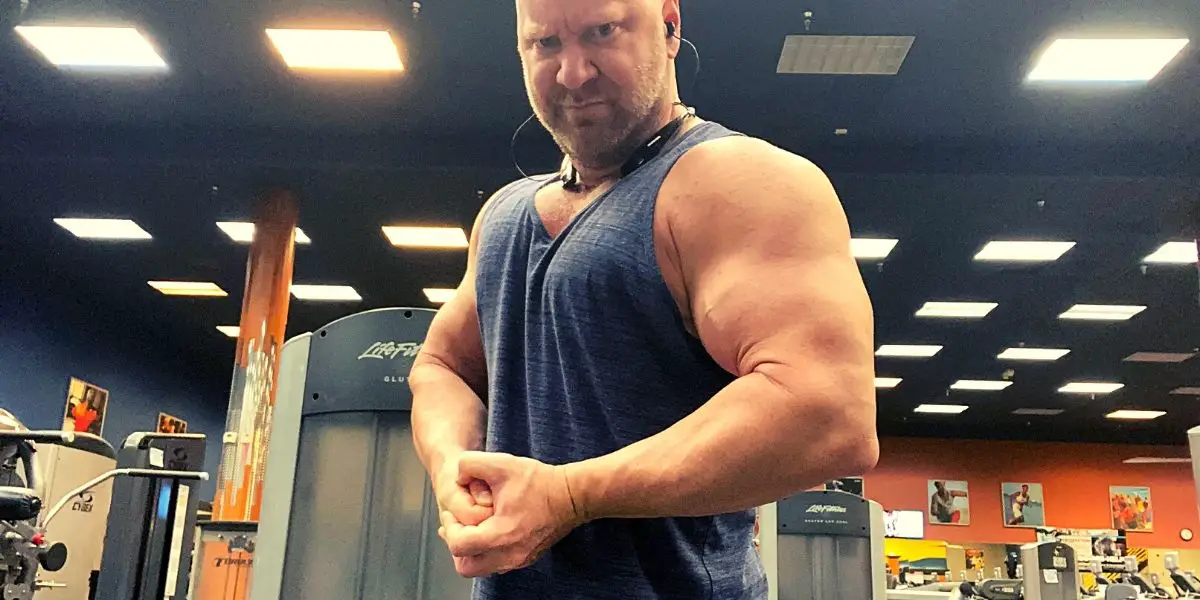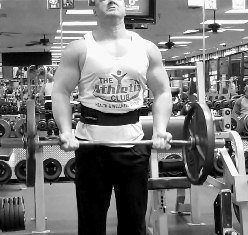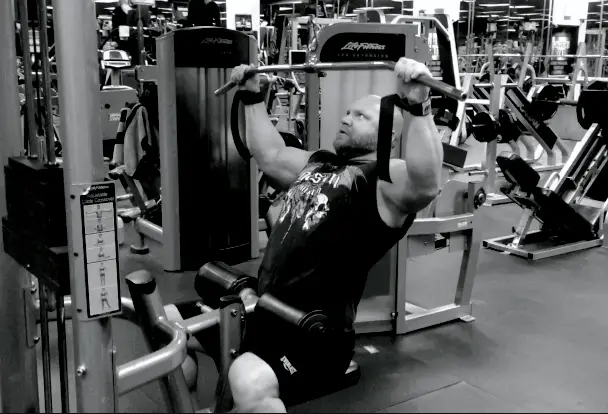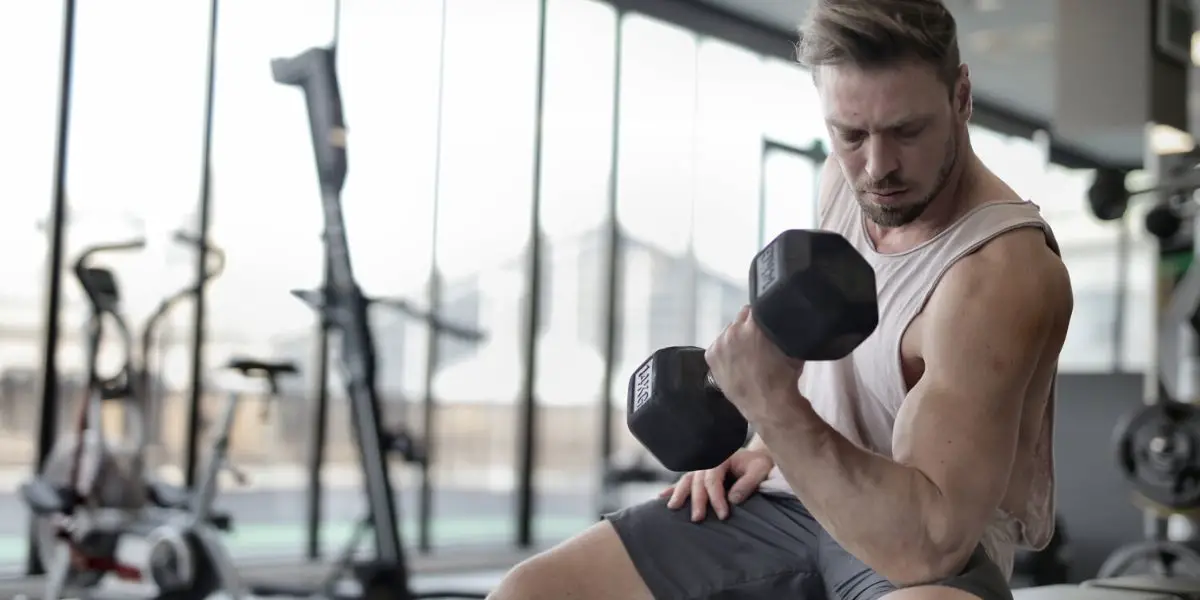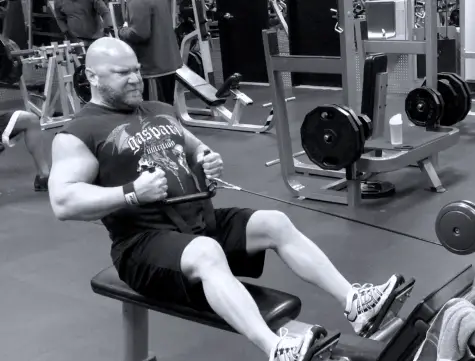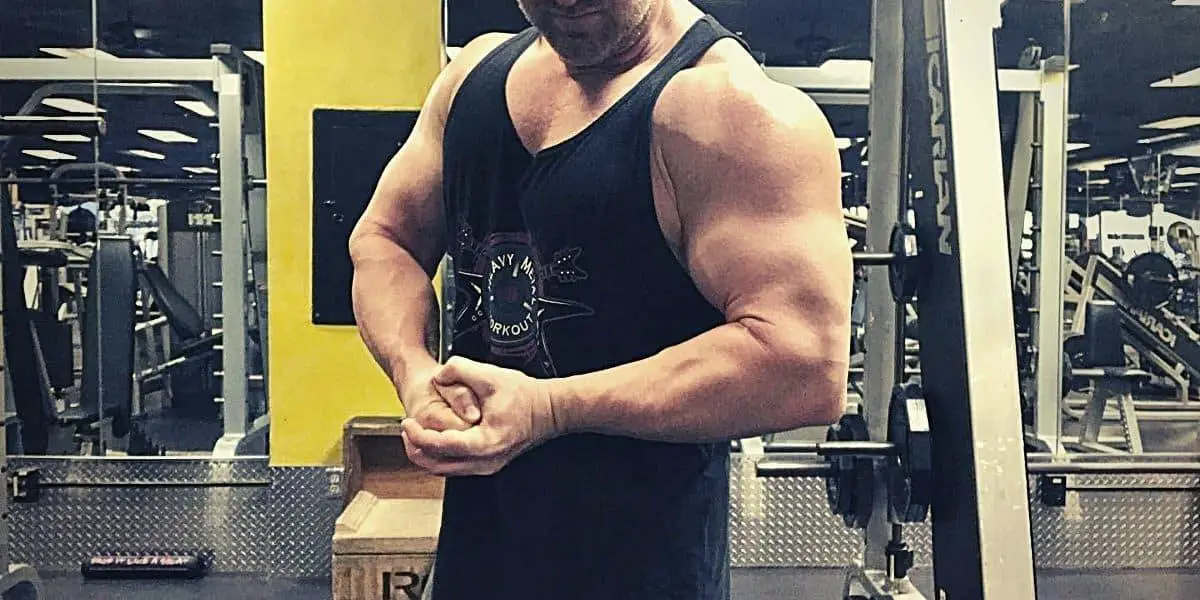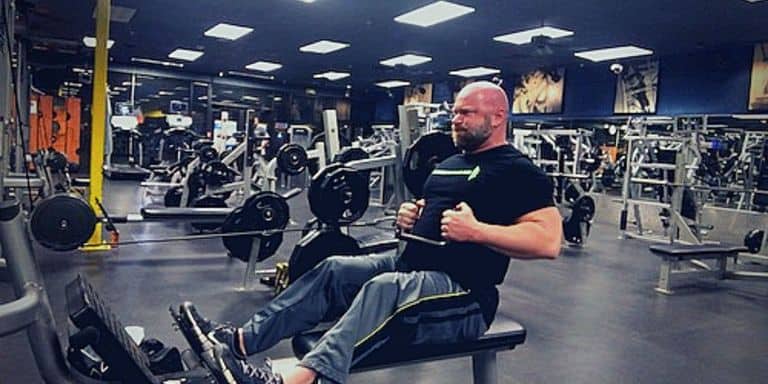How to Gain Muscle Mass Without Getting Fat (Complete Guide)
So, you want to gain muscle mass, right? You want to pack on size and get huge!
The problem is that whenever you see one of your buddies trying to gain mass they also gain too much fat to go with it. And that’s not the look you’re going for.
You’re going for that jacked-up look. In other words, you want to see the muscle you gain rather than it being covered by layers of blubber.
In this post, I’m going to show you exactly how to gain muscle mass without getting fat. You’ll learn everything you need to do from how to structure your workouts, methods that give both mass and muscle separation, and I’ll even tell you what (and how) to eat.
Are you ready?
Here are your contents:
Your Zone: Mental Aspect of Gaining Mass
Types of Exercises for Mass Gains
Sets and Reps for Building Mass
Increasing Workout Intensity for Mass Gains
Workout Routine for Quality Mass
Foods for Quality Mass Gains
Meal Plan for Gaining Mass without Getting Fat
Additional Tips for Mass Gains without Fat Gain
Your Zone: Mental Aspect of Gaining Mass
It’s one thing to just want to gain mass. In other words, some people simply want to pack on size and they may not care if they gain some fat.
Heck, that’s easy! Just eat a ton of calories and train hard and heavy!
**If you’re a true hardgainer (meaning you have trouble gaining weight), that may be where you want to start. If that’s you, then go check out this guide I created: 5 Muscle Building Tips for Hardgainers.
But I assume that’s not your goal (hence you’re reading this!). Rather, you want to gain quality muscle mass without accumulating body fat.
I’m not going to sugarcoat this. It’s going to be tough! And it’s going to be more of a gradual process.
Building muscle mass without getting fat requires two things:
- Extreme discipline
- Specific strategies
Discipline, or what I like to call ‘your zone,’ is what we’re talking about in this section (we’ll get to the strategies shortly!).
***Do not skip this section!
This short section may seem off-topic at a glance. But trust me when I tell you that it’s completely relevant. Your mental state is crucial to your success!
I won’t belabor the point here, but you need to understand that building size while not gaining fat requires you to perform at a completely different level than others, and probably where you are now, even though you already train hard!
How to Maintain Discipline (Your Zone)
Your ability to maintain discipline has everything to do with your mindset…
- The way you think
- Your perception of circumstances
- Your ability to maintain complete and total focus
Don’t worry, it’s not that complicated. And I’m going to break this down for you with some helpful actions you can take on a daily basis to get in (and stay in) your zone:
- Don’t compare yourself to others. The battle is you against you, not anyone else. If you start to focus on others you’re more apt to lose focus on your own goals.
- Have someone that you’re accountable to. This could be your training partner or even a group of like-minded people. But you need someone who will be honest with you and push you to that next level.
- Shun negativity. Whether it’s the news, social media, or people, get rid of, or at least greatly reduce any negativity in your life. This will hinder your gains, for sure.
- Don’t stress. Now, you may be thinking ‘Jason, that’s easier said than done!’ Here’s the thing – stress increases cortisol, which decreases glucose intake into the muscles, according to WebMD’s article ‘What Is Cortisol?‘
- Set a schedule and stick to it. Gaining size with no fat isn’t going to happen if you’re missing workouts, meals, or not getting enough rest. Build your schedule around your goals and stick to it.
- Clear your mind before every workout. Before you step into the gym, you need to be 100% focused. You’re going to be training hard, heavy, and with max effort. So an hour before you train, take some time to meditate and reflect on your ultimate goal of packing on quality muscle size.
Remember, your mental state has everything to do with your results (or lack of). Use these tips to get into your zone.
Types of Exercises for Mass Gains
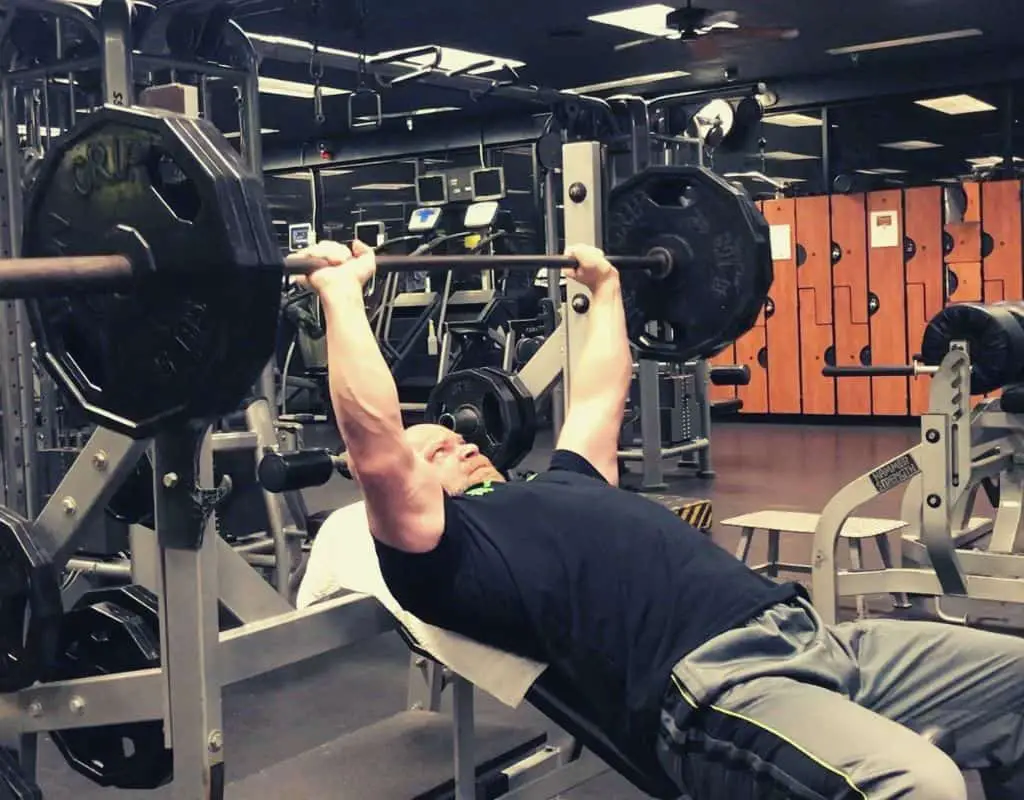
Now for the fun stuff. The rest of this post is going to be your complete training guide for gaining muscle mass without getting any fat.
There are specific exercises you’ll want to focus on for building quality muscle size. More importantly, there’s a particular order of exercises you should follow in your workouts, as you’ll see below:
| Time of Your Workout | Exercise Order Strategy |
|---|---|
| Beginning of your workout | Compound exercise that builds dense muscle mass |
| Middle of your workout | Modified-compound exercises for further muscle development |
| End of your workout | Isolation exercises that build and shape the muscle |
Now let’s get into the actual exercises you need to be doing for mass gains…
Compound Exercises for Dense Muscle Mass
The first exercise you do for any muscle should be a compound exercise. These are also called multi-joint exercises.
Compound Exercises:
- Squats
- Deadlifts
- Barbell Rows
- Overhead Barbell Press
- Bench Press
Why do you need compound exercises for mass gains? There are two reasons:
- Going heavy on these exercises will build thick, dense muscle mass.
- These exercises will help you get stronger on the other exercises to come, which means you’ll be able to further overload your muscles, forcing them to grow (we’ll talk more about that later).
Compound exercises give you the best bang for your buck, so to speak. This is why they are to be performed at the beginning of your workouts.
This may start to sound like a powerlifting program but these types of exercises are key for bodybuilding, according to Ryan Patrick’s article ‘6 Compound Training Movements that Build Serious Mass‘ on Bodybuilding.com. However, we’re not stopping because there’s much more…
Modified-Compound Exercises for Muscle Development
Modified-compound exercises are exactly that; they are a modified version of a compound movement. The difference is they allow you to target the specific muscle better than the original exercise.
Examples of Modified-Compound Exercises:
- Dumbbell Rows
- T-Bar Rows
- Leg Press
- Stiff-leg Deadlifts
- Incline Bench Press
- Dumbbell Presses (for chest and shoulders)
- Upright Rows
*There are also several machines that mimic these exercises, giving you even more options in the gym.
These are often considered the culprit of bodybuilding exercises. They help complement the core compound exercises by further developing your muscles by targeting those muscles at a deeper level.
Also, these exercises will make up the ‘bulk’ of your workout (no pun intended). Modified-compound exercises add so much value to the muscle-building process because they are a hybrid between building dense mass and shaping your muscles.
Isolation Exercises for Shaping Your Muscles
Towards the end of your workout, you’ll perform one or more isolation exercises. These are exercises that target a specific muscle deeper than any other type of exercise.
Examples of Isolation Exercises:
- Dumbbell Flyes
- Cable Crossovers
- Pec-Dec Flyes
- Lateral/Front/Bent-Over Raises
- Leg Curls
- Leg Extensions
- Calve Raises
- All Arm Exercises
- Lat Pulldowns
- Seated Rows
**There are some exercises listed as isolation exercises, like lat pulldowns and seated rows, that could easily be classified as modified-compound exercises. These are thrown into the isolation exercise bucket because they’re performed with cable machines, not free weights. Not having that balance requirement from free weights helps isolate that specific muscle even more.
***Most machine exercises can be classified as isolation exercises, even though they may mimic compound and modified-compound exercises. Again, this is due to the direct stimulation of the muscle as you’re not having to balance as you would with free weights.
Isolation exercises are where you get into shaping your muscles with that deep burn. I have a blog that goes deeper into this called ‘How to Define and Shape Your Chest‘ that you can read later.
These movements also help keep your body fat down as you’ll typically be doing more overall reps and resting less between sets, which we’ll get into below…
Sets and Reps for Building Mass
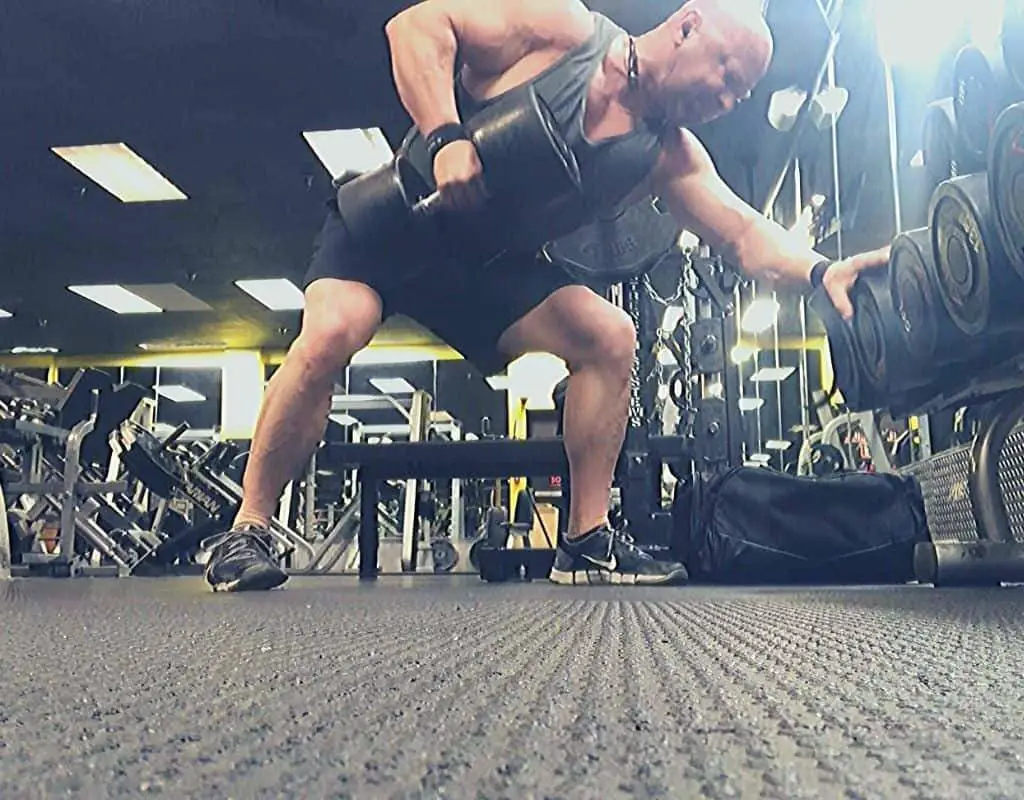
You’ve got the exercises and proper order of exercises for your workouts. But how many sets and reps should you be doing to build mass?
This is where we can get into some controversy. At a high level, there are two schools of thought:
- Short, super intense workouts
- Long workouts with more volume
They both have their place and there are professional bodybuilders who have achieved results from both.
The real truth about how many sets and reps you should perform is found somewhere in the middle. For the purpose of packing on size while not gaining fat, we’re going to lean towards doing more volume. But don’t worry, your workouts are still going to be intense!
Remember the exercise order? Let’s combine that with sets and reps below:
| Type of Exercise | Sets | Reps |
|---|---|---|
| Compound exercise | 4-5 | 6-8 |
| Modified-compound exercises | 3-4 | 8-10 |
| Isolation exercises | 3-4 | 12-15 |
Basically, you’ll start out lifting heavier weights. Why? Because compound exercises are using more muscles so you want to take advantage of the strength gains that come from that. And remember, this builds that dense muscle mass.
Once you get into your modified-compound and isolation exercises, your reps will gradually increase with each exercise. This is to pump more blood into your muscles for the purposes of increasing their size.
**If you’d like to learn more about how rep ranges affect muscle growth, read my post: High Reps VS Low Reps
Increasing Your Workout Intensity
I mentioned intensity earlier when comparing short, intense workouts vs high volume workouts for mass gains. It’s safe to say that your entire workout is going to be intense.
However, there’s a specific time where you’ll drastically increase the intensity. This will be towards the end of your workout and usually on the final set. All of the sets prior to that will build up are to pump more blood into the muscle and build up to that final set where you’ll go all-out.
The goal here is to:
- Break down the muscle tissue so that you can rebuild it (we’ll talk about recovery later)
- Get that deep muscle separation
- Boost your heart rate and burn even more calories to help keep body fat down
There are two methods you’ll often use towards the end of your workouts…
- Rest-pause sets
- Drop sets
Both will allow you to exhaust your muscles and build size. Because of the intensity, they may also alter the shape of your muscles, giving you that bodybuilder physique (deep muscle separation), which is your ultimate goal.
Rest-pause sets work like this:
- Perform a set
- Rest for 15-20 second
- Perform another set using the same weight
**You may read where some rest for shorter or longer periods but 15-20 is ideal for this workout.
Drop sets workout like this:
- Perform a set
- Reduce the weight by about 30%
- Immediately perform another set
You’ll be using both of these techniques throughout your workouts, which we’re getting to below…
Workout Routine for Quality Mass
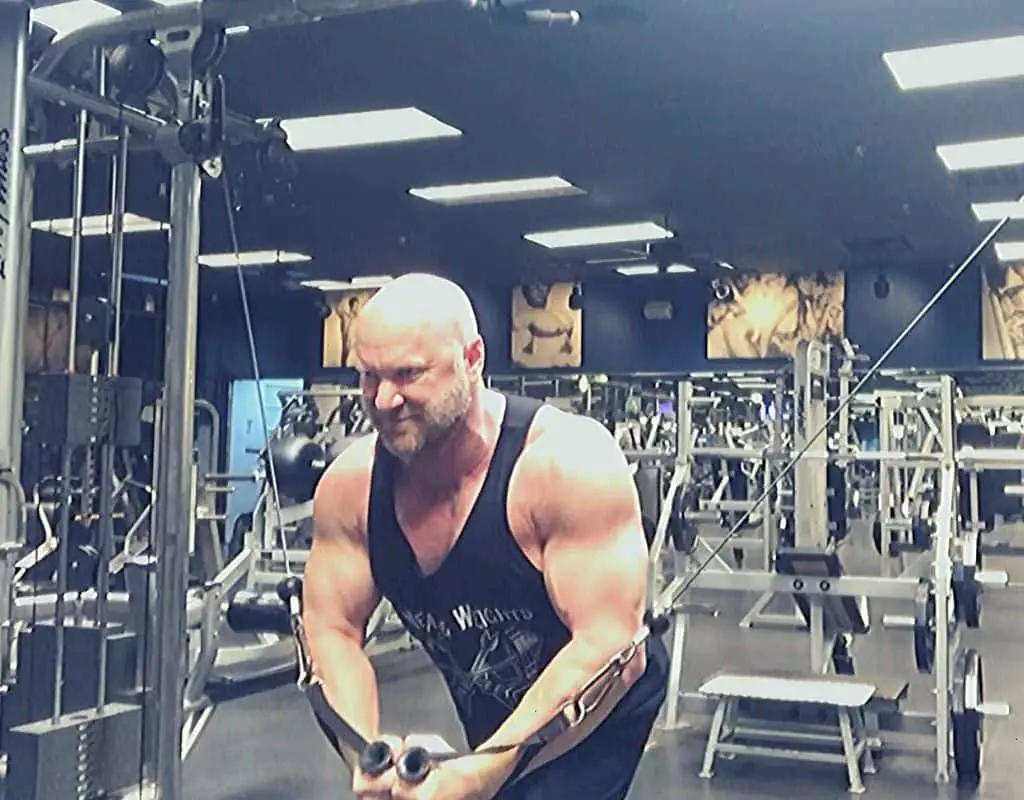
It’s time to put all of this together to come up with a workout plan for packing on size while not getting fat!
I’m going to give you the full details of each workout and you’ll also see notes on how the methods we just discussed are used.
Training Split
This is a 5-day a week split. You can rearrange the training days to fit your schedule; this is just provided as an example for someone who prefers having the weekends off.
| Day | Workout |
|---|---|
| Monday | Back |
| Tuesday | Legs |
| Wednesday | Chest and Biceps |
| Thursday | Shoulders and Triceps |
| Friday | Legs and Back* |
| Saturday | Rest |
| Sunday | Rest |
*There’s a ‘huge’ reason why you’re training back and legs twice a week. I’ll explain when we get to the final workout below.
Rest Between Sets
- Compound Exercises: 2 minutes between sets
- Modified-Compound and Isolation Exercises: 45 seconds to 1 minute between sets
- Isolation Exercises: 45 seconds between sets
You will only have one compound exercise for each workout, which is the one you’ll start with. You’ll always end with an isolation exercise (some workouts you may have more isolation exercises).
Workout 1: Back
| Exercise | Sets x Reps |
|---|---|
| Barbell Rows | 5 x 6-8 |
| Dumbbell Rows | 4 x 8 |
| T-bar Rows | 4 x 8-10 |
| Seated Rows | 4 x 10-12* |
| Lat Pulldowns | 3 x 12-15** |
*Perform a rest-pause set on the final set
**Perform a drop set on the final set
You’re doing more volume for your back than the rest of your upper body parts. Back is the largest and most complex upper body muscle. So it makes sense to give it more attention.
It’s also important to work your back muscles from different angles. For every other back workout, you can try using different grips or alternating the way you perform specific exercises.
For example, for the even weeks (every other back workout) you could to close-grip pulldowns and wide-grip seated rows. You can read more about back training in my post: 3 Powerful Tips to Make Your Back Muscles Stand Out
Workout 2: Legs
| Exercise | Sets x Reps |
|---|---|
| Squats | 5 x 8-10 |
| Stiff-leg Deadlifts | 4 x 10 |
| Leg Press | 4 x 12 |
| Leg Extensions | 4 x 15** |
| Leg Curls | 4 x 10* |
| Seated or Standing Calve Raises | 7 x 15* |
*Perform a rest-pause set on the final set
**Perform a drop set on the final set
You’ll noticed that the reps are slightly higher than your upper body exercises. This is because legs, specifically quads, tend to respond better to higher reps when it comes to muscle growth.
This is due to the different types of muscle fibers in most people’s quads. However, many bodybuilders feel that hamstrings respond best to 8-10 reps. So that’s why there’s a difference.
Workout 3: Chest and Biceps
| Exercise | Sets x Reps |
|---|---|
| Bench Press | 4 x 6-8 |
| Incline Bench Press | 4 x 8 |
| Cable Flyes | 3 x 10-12* |
| Machine (Hammer Strength) Press | 3 x 12-15** |
| Dumbbell Pullovers | 2 x 10 |
| EZ Bar Curls | 3 x 10* |
| Dumbbell Hammer Curls | 3 x 10* |
*Perform a rest-pause set on the final set
**Perform a drop set on the final set
I want to add a special note for bench press. Don’t get caught up in how much weight you can bench. That’s not important when you’re training for mass.
On the other hand, I’ve heard some say that bench press doesn’t build your chest muscles. Those people are dead wrong.
It is, however, all in the way you perform the exercise. You need to make sure you’re forcing your chest muscles to do the work. So just remember to leave your ego at the door before you get on the bench press.
*If one of your goals is to increase your bench press, read my post: Increase Your Bench Press: Critical Bench 2.0 Review
Workout 4: Shoulders and Triceps
| Exercise | Sets x Reps |
|---|---|
| Seated Barbell Press | 4 x 6-8 |
| Seated Dumbbell Press | 4 x 8 |
| Lateral Raises | 3 x 10-12* |
| Bent-over Raises | 3 x 10-12* |
| Upright Rows | 2 x 10* |
| Seated Overhead Dumbbell Extensions | 3 x 10 |
| Rope Pressdowns | 3 x 10** |
*Perform a rest-pause set on the final set
**Perform a drop set on the final set
The structure of this workout is similar to the prior workout for chest and biceps. Both are designed for maximum mass gains.
For shoulders, you can always mix it up by doing different variations of these exercises (as explained on back day).
For example, one week you may want to substitute lateral raises with front raises. Or you may do Arnold press instead of regular dumbbell press. Feel free to change things up every other week.
Workout 5: Legs and Back
| Exercise | Sets x Reps |
|---|---|
| Squats | 4 x 15 |
| Leg Extensions | 4 x 15** |
| Seated Calve Raises | 75s*** |
| Reverse Grip Bent-over Rows | 4 x 15 |
| Pull-ups | 4 x 10** |
**Perform a drop set on the final set
***The ’75s method’ is basically a giant rest-pause set; pick a weight you can do for about 20 reps, and continue with the same weight, resting about 10-15 seconds between sets, until you complete at least 75 total reps
You may be wondering why you’re training back and legs twice a week. As I mentioned or back, legs are similar as both are the largest muscles in your body.
In this 2nd workout for legs and back, you’re going to go a bit lighter and pump out more reps. Your goal here is pumping more blood into those muscles. This will help work different fibers that may have not been trained as much during your prior leg and back workouts.
In addition, training these large muscles will help you pack on more overall muscle mass.
*I have articles on both of these subjects if you’d like to learn more…
Training Legs Twice a Week: How to Build Bigger Legs
Training Back Twice a Week to Build Ripped Muscle Mass
What About Cardio and Abs?
No matter what level you’re at, it’s important to do some type of cardiovascular exercise fo 20-30 minutes, 2-3 times a week.
The only exception would be if you’re active in other sports or activities where you’re burning a substantial amount of calories.
This is something you really have to gauge as it’s different for everyone. Doing too much cardio can indeed eat into your muscle gains. But there’s also a great to cardio benefit beyond just building muscle. So you have to find the right balance that works for you.
Personally, I walk at a moderate pace for 25-30 minutes, 4-5 times a week. I’m older and tend to hang onto body fat easier these days, to this works best for me.
As far as training abs, I’ll leave that up to you. The compound exercises and intensity of your workouts will stimulate your core. But feel free to do some direct ab training 2-3 times a week.
Foods for Quality Mass Gains
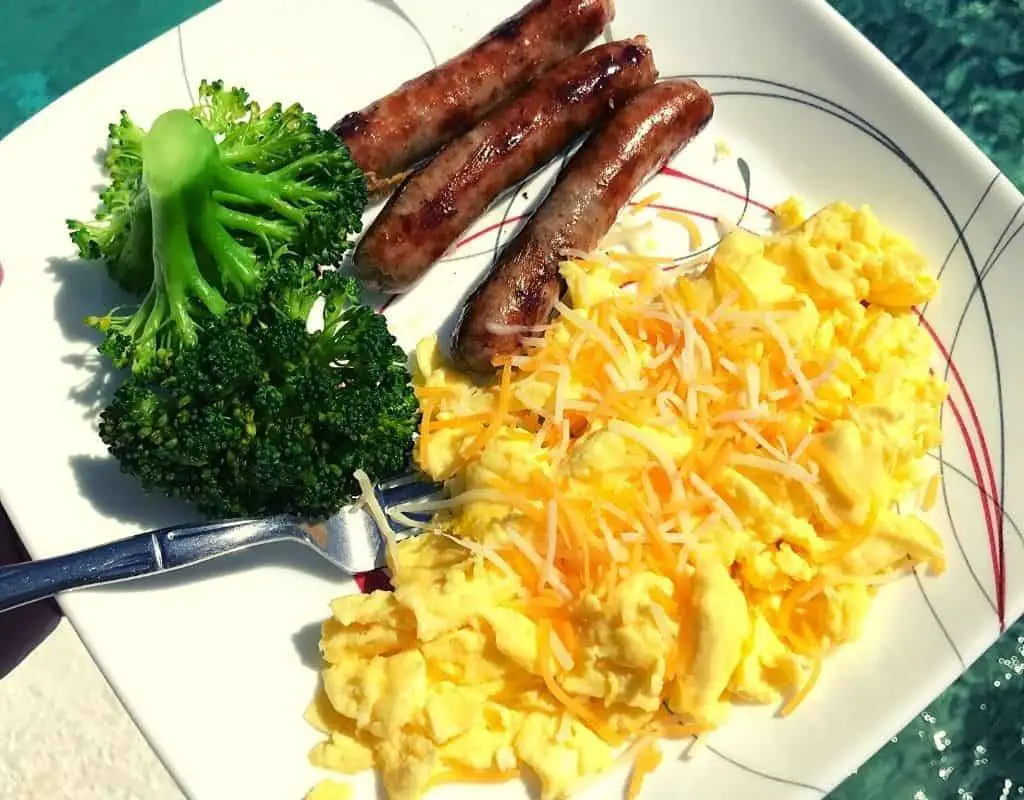
Now you’ve got an entire workout routine for gaining muscle mass without getting fat. But this plan would not be complete without addressing nutrition.
Training is only half of the equation. In fact, many pro bodybuilders will tell you that nutrition is actually more important than training.
Pro bodybuilding and 4-time Mr. Olympia Jay Cutler explains how crucial nutrition is to bodybuilding in this video:
Bodybuilding nutrition has been made more complex than necessary. There are so many different diets and many of the contradict one another.
Here’s the thing, and you’ll read this in almost very nutrition post on my site, there is no one-size-fits-all diet. We’re all different and what works great for one bodybuilder may not work so well for another.
However, there are some basic nutrition concepts you need to be aware of for gaining size without gaining body fat.
Foods to Avoid
First, let’s start with the types of foods you want to limit or avoid altogether.
- Processed foods
- Foods high in sugar or with added sugars
- Foods with trans fats
- Foods that have unnatural or artificial ingredients
These types of foods may help you gain size because you’re getting the calories needed to grow. But they could also cause you to gain body fat for the same reason as you’re often eating more calories than you need to grow, not to mention that your body cannot process many of these processed ingredients.
More importantly, some of this junk can lead to health problems. Putting your health at risk also puts your gains at risk.
Foods that Build Muscle Mass
On the contrary, here are some basic foods that will help you pack on quality muscle size…
- Free-range eggs
- Greek yogurt
- Blueberries (or any dark berries)
- Oatmeal
- Lean beef/steak
- Lean pork
- Fatty fish (ex: salmon, cod, trout)
- Whole grains
- Sweet potatoes
- Green vegetables
- Healthy oils (ex: olive, coconut, peanut oil)
- Nuts
You could essentially use this as your mass-building grocery list and be just fine.
Also, keep in mind that I recommend buying certified organic foods.
Protein, Carbs, Fats
You need all macronutrients in your diet if you truly want to gain muscle mass and boost your metabolism. These nutrients provide your muscles with the ability to recover and grow new muscle tissue.
Balancing your protein, carbs, and fats will also help keep your metabolism up in response to your intense training. If you were to eat this amount of daily food and not workout hard, you would certainly run the risk of gaining fat from the overall calorie intake.
Do not let anyone talk you into a diet that eliminates carbs, or fat, or greatly reduced protein. All macronutrients play a key role in both building muscle mass and overall health (providing the vitamins and minerals your body needs).
**You may notice that macros are not discussed in detail below. If you feel you need to count macros, read my post: 5,000 Calories Mass Building Meal Plan
Meal Plan for Gaining Mass without Gaining Fat
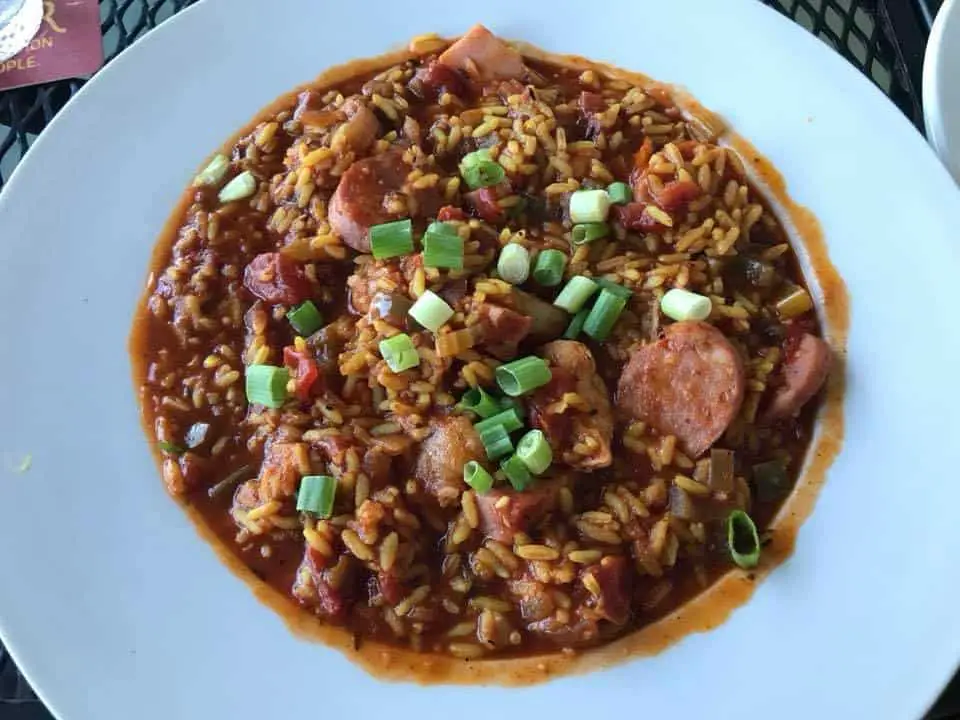
Let’s take your nutrition to the next level. I’m now going to a full mass-building meal plan.
- This is an example of one day’s worth of meals
- The amounts listed should be catered to your own needs (these are just examples)
- The below example follows (approximately) the 40/40/20 macronutrient ratio plan: 40% protein, 40% carbs, 20% fats – you will need to experiment to see what works best for you, but this is a good starting point
- You can use this as a guide to creating your own meal plan
*NOTE: This meal plan is based on a morning workout schedule. If you train at any other time, just rearrange the meals accordingly.
Meal 1 – 5:00 AM (Pre-workout)
- 1 scoop of whey protein powder
- 1 serving of oatmeal
- 1/2 serving of natural peanut butter
Meal 2 – 7:00 AM (Post-workout)
- 2 scoops of whey protein
- 8 ounces of almond milk
- 1 serving of frozen blueberries
- 1 banana
- 1/2 serving of natural peanut butter
Meal 3 – 9:30 AM
- 3-4 whole eggs
- 1 serving of red potatoes
- 2-3 turkey sausage links
- 1 apple
Meal 4 – 12:30 PM
- 8-10 oz of lean pork or chicken
- 1-2 servings of brown rice
- 1 serving of chickpeas
- 2 servings of green vegetables (broccoli, spinach)
Meal 5 – 3:30 PM
- 2 servings of Greek yogurt
- 1 serving of nuts
Meal 6 – 6:30 PM
- 8-10 oz of fish or sirloin
- 2 sweet potatoes
- 2 servings of green vegetables (broccoli, spinach)
Meal 7 – 9:30 PM (Optional)
- Greek yogurt or protein powder
- Nuts or peanut butter
**I’ve got a source for some amazing bodybuilding recipes if you’re having trouble deciding what to cook, or if you’re like me and get bored with eating the same foods. Read my post: Anabolic Cooking Review
What About Cheat Meals?
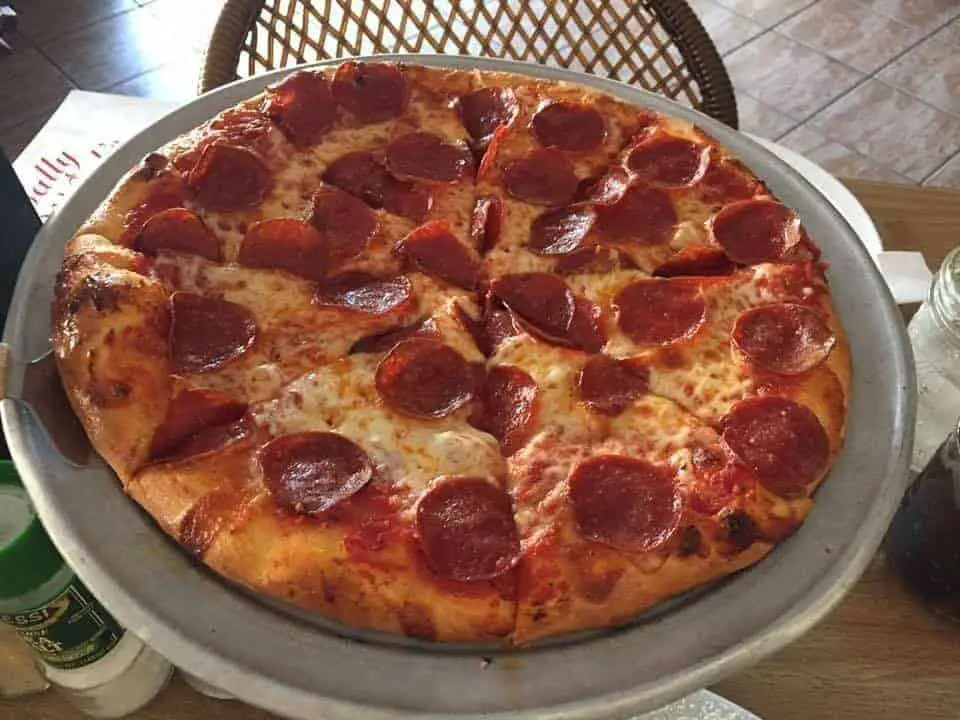
Cheat meals are certainly okay when building mass. Just don’t overdo it. And be honest with yourself about where you’re at and where you aspire to be.
In other words, if you’re on the heavy side already holding too much body fat, then you may want to stay away from cheat meals for 6-8 weeks and get your body fat under control. Of course, if that’s the case I would expect you to be a different program, like my Lean Muscle Building Program.
If you’re already fairly lean or if you’re a hardgainer, you can stand 2-3 cheat meals per week, maybe more. Just make sure you’re also getting enough quality nutrients in on those days.
Additional Tips for Mass Gains without Fat Gain
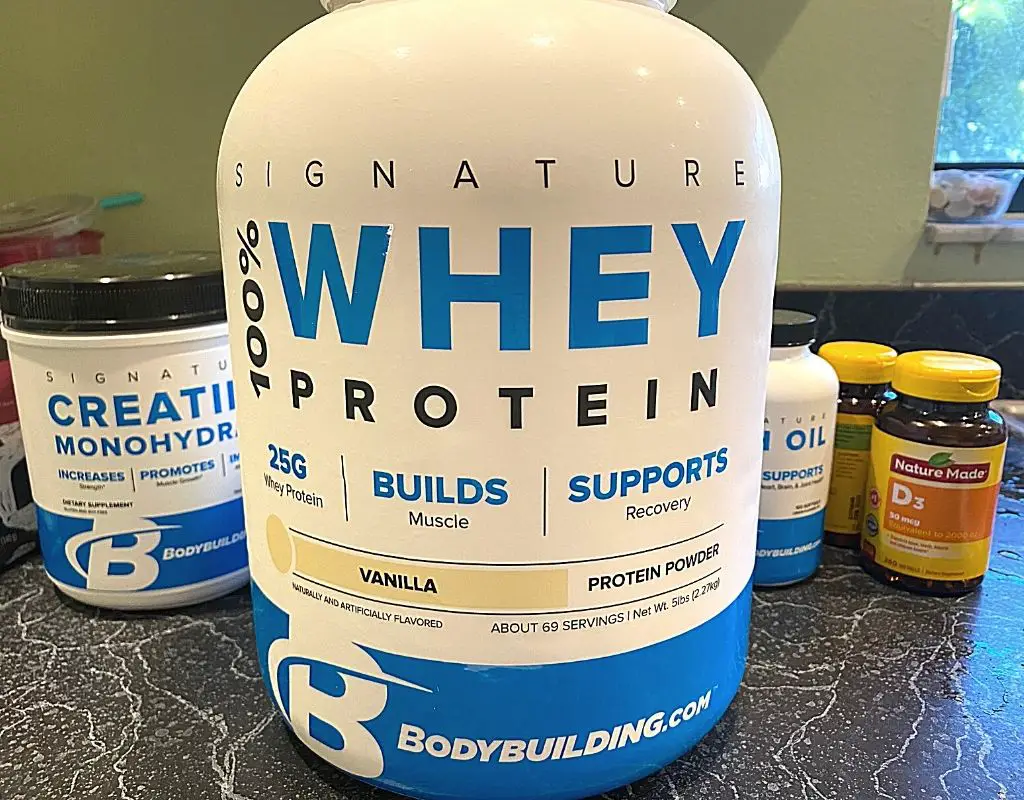
We’ve gone over the two basic yet extremely crucial components of packing on more muscle mass. Oh, wait…there’s a third…
We also went over your mindset and how to get in your zone in the beginning!
There’s just one last thing I’d like to cover, and there’s a reason why I saved this for the end. I want to give you a shortlist of supplements that can help you gain muscle mass and that will also help reduce fat.
But first, understand that supplements are not necessary to get results. If your mind is in the right place, you train hard, and you’re eating enough quality calories to recover and grow, you will make some awesome progress.
Supplements are just that – supplements. They are to supplement what you’re already doing right. And they’re also to help ensure you’re not deficient of any micronutrients (vitamins and minerals).
So here’s my short list of supplements for gaining quality mass:
- Creatine – This gives your muscles more energy
- Multivitamin – To ensure you do not have any micronutrient deficiencies (we don’t always get enough in our diet)
- Whey protein – Comes in handy for pre and post-workout meals
- Pre-workout – This can help give you that extra boost of energy you need for your workouts (better workouts = more gains!)
- Natural testosterone booster – This can help with hormone production, which is important for muscle growth
**You can read about what I personally take on my resources page here: Jason’s Resources
I hope you found this helpful! It’s essentially an entire program. So I encourage you to scroll up and read this again (you’ll be surprised at what you pick up in this article the 2nd time around…there’s a lot of ‘meat and potatoes’ in here!).
Also, please share this post with others if you feel it will help them!
Train with Passion,
Jason
